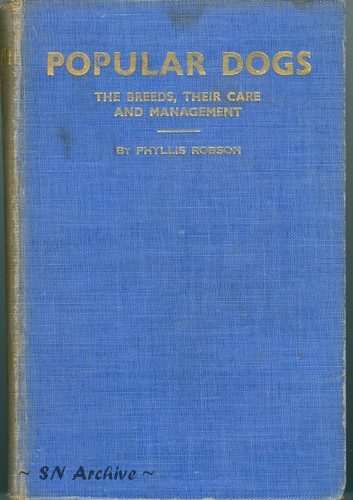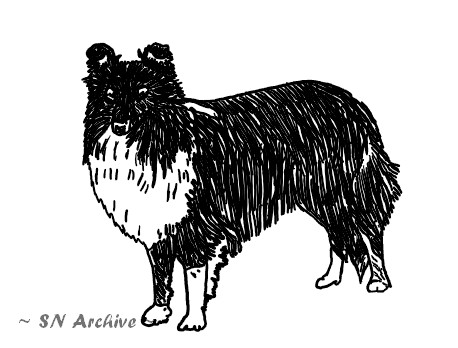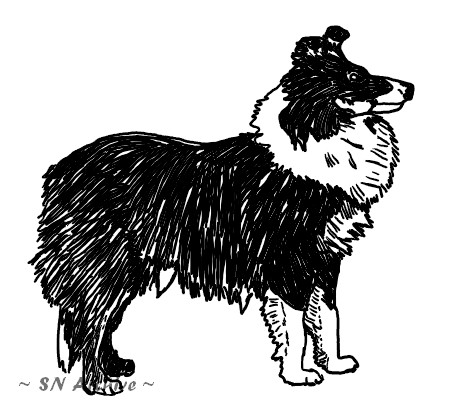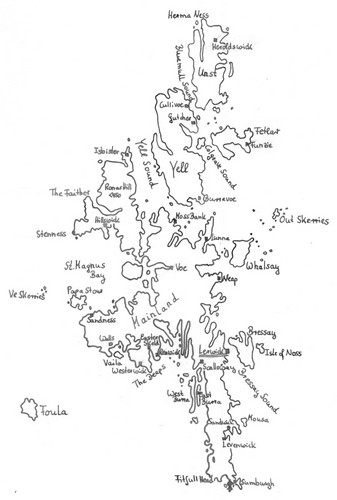 |
POPULAR DOGS THE BREEDS, THEIR CARE AND MANAGEMENT Phyllis Robson, Popular Dog Publishing Company Ltd., 1949 (1st) |
The author was the editor of the weekly magazine Dog World and she wanted to offer the beginner a guide with this book. It is an interesting work with numerous drawings and kennel advertisements showing quality dogs of their time. There is one page on the Sheltie and the "Houghton Hill" kennel of Mrs. Edith Baker shows in their ad on page 281 the very beautiful tricolour males "CHAMPION UAM VAR OF HOUGHTON HILL
"CHAMPION UAM VAR OF HOUGHTON HILL
by Nut of Houghton Hill ex Lace Cap of Houghton Hill. He won his Certificates at Kensington, 1929 (Mrs. T. Care), Crufts 1930 (Mr. T. W. Marples) and Windsor 1930 (Miss Tyssen). He is also the winner of 28 firsts, several bein in Variety classes. He was bred in the Kennel by Mrs. Baker and is 14 1/2 inches high." and
"SPRIG OF HOUGHTON HILL (at 9 1/2 months)
By Ch. Uam Var of Houghton Hill ex Chestnut Garland. Born Feb. 10th, 1930. He won 4 firsts and C.C. at Kensington (under Miss Thynne), 3 firsts and C.C. at Bath (under Mr. C. Campbell). He is of the ideal hight of 13 1&2 inches."
A few phrases of Mrs. Robson's breed description appears somewhat strange for today's breed lovers. She also mentions that the Sheltie was first shown at Cruft's Dog Show in 1907. I can't find a hint of this in the Cruft's catalogues - even under 'Any Other Variety' or anywhere else that year. I suspect that one author copied from another and that it was another important Kennel Club show where the Sheltie first was shown in the south.
Page 280: "THE SHETLAND SHEEPDOG
THE Shetland Sheepdog is a sturdy, altogether admirable little companion dog, most attractive in appearance and possessing all the wisdom and sagacity of the Collie upon which it is modelled. Standing no more than fourteen inches at the shoulder this midget sheepdog is used for work in the Shetland Islands where the sheep are small. The body is long and set low on rather short legs which end in long shaped, feathered feet. The tail is a substantial brush, beautifully carried, and the coat is long, flat and inclined to silkiness, with a considerable neck frill. The colours and points are similar to those of the larger working Collie. The variety has always been associated with the northern islands and with the strenuous work of tending sheep, and a Sheltie should always be judged as a mere miniature edition of the show Collie. At the same time it is an ornamental dog and there is excuse for the cultivation of its beauty in a well-groomed coat and rectitude of type. One of its many charms is its grace of action and attitude. While possessing all the attractions of a drawing-room pet, it is not to be classed as a Toy. It belongs to the group of smaller companion dogs of which the Schipperke, the Keeshound, and the Schnauzer are members.
The Shetlander has been known in the South since about 1907. The East Coast fisherman visiting the fishing grounds off the Shetland Islands occasionally brought home specimens as domestic pets and these attracted the attention of English dog-lovers who adopted them in their breeding kennels. It was in the year mentioned that the breed was first exhibited at Cruft's and gained many admirers. Since that date it has made steady progress and is now to be seen at most of the important shows. For a time there was a tendency to enhance the resemblance to the show Collie by interbreeding, but this was a retrograde movement. The clubs fostering the variety have successfully insisted on the little Sheltie being regarded as a unique breed of fixed type, and the danger of its being increased in size has been averted. This is an important consideration. The salient characteristic is its diminutive size in comparison with the pastoral dogs of other lands. Like the Shetland pony it would lose its peculiar charm if it were magnified beyond its midget proportions."
If you discover any errors in the text that may have been caused by the transcription, please let us know for a prompt correction.

